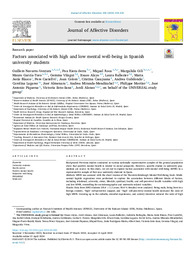Por favor, use este identificador para citar o enlazar este ítem:
https://hdl.handle.net/11000/36101Registro completo de metadatos
| Campo DC | Valor | Lengua/Idioma |
|---|---|---|
| dc.contributor.author | Navarra-Ventura, Guillem | - |
| dc.contributor.author | Riera-Serra, Pau | - |
| dc.contributor.author | Roca, Miquel | - |
| dc.contributor.author | Gili, Margalida | - |
| dc.contributor.author | García-Toro, Mauro | - |
| dc.contributor.author | et. al | - |
| dc.contributor.other | Departamentos de la UMH::Psicología de la Salud | es_ES |
| dc.date.accessioned | 2025-03-24T16:20:47Z | - |
| dc.date.available | 2025-03-24T16:20:47Z | - |
| dc.date.created | 2024 | - |
| dc.identifier.citation | Journal of Affective Disorders Volume 356, 1 July 2024, Pages 424-435 | es_ES |
| dc.identifier.issn | 1573-2517 | - |
| dc.identifier.uri | https://hdl.handle.net/11000/36101 | - |
| dc.description.abstract | Background: Previous studies conducted in various nationally representative samples of the general population show that positive mental health is related to social prosperity. However, specific studies in university pop- ulations are scarce. In this study, we set out to explore factors associated with mental well-being (MWB) in a representative sample of first-year university students in Spain. Methods: MWB was assessed with the short version of the Warwick-Edinburgh Mental Well-Being Scale. Multi- nomial logistic regressions were performed to explore the association between different blocks of factors, including relational, adversity, stress, lifestyle, spiritual, health, and self-perceived health variables with high and low MWB, controlling for sociodemographic and university-related variables. Results: Data from 2082 students (18.6 ± 1.2 years; 56.6 % females) were analysed. Being male, being born in a foreign country, “high” self-perceived support, and “high” self-perceived mental health increased the odds of high MWB. Growing up in the suburbs, stressful experiences, and anxiety disorders reduced the odds of high MWB. Mood and anxiety disorders increased the odds of low MWB. “Middle” self-perceived support, sleeping ≥8 h per day, and “high” self-perceived mental health reduced the odds of low MWB. Limitations: The cross-sectional design precludes establishing causal relationships. Data were collected in the 2014–15 academic year using self-reported online surveys. Conclusion: The factors associated with high and low MWB do not always mirror each other, so specific plans are needed to successfully address each of the two poles. Interventions and policies targeting these factors for health promotion and disease prevention would improve the MWB of university students. | es_ES |
| dc.format | application/pdf | es_ES |
| dc.format.extent | 12 | es_ES |
| dc.language.iso | eng | es_ES |
| dc.publisher | Elsevier | es_ES |
| dc.rights | info:eu-repo/semantics/openAccess | es_ES |
| dc.rights | Attribution-NonCommercial-NoDerivatives 4.0 Internacional | * |
| dc.rights.uri | http://creativecommons.org/licenses/by-nc-nd/4.0/ | * |
| dc.subject | University students | es_ES |
| dc.subject | Health survey | es_ES |
| dc.subject | Positive mental health | es_ES |
| dc.subject | Subjective well-being | es_ES |
| dc.subject | SWEMWBS | es_ES |
| dc.subject | WMH-ICS | es_ES |
| dc.subject.other | CDU::1 - Filosofía y psicología::159.9 - Psicología | es_ES |
| dc.title | Factors associated with high and low mental well-being in Spanish university students | es_ES |
| dc.type | info:eu-repo/semantics/article | es_ES |
| dc.relation.publisherversion | https://doi.org/10.1016/j.jad.2024.04.056 | es_ES |

Ver/Abrir:
2024_HIGH AND LOW WELLBEING.pdf
978,29 kB
Adobe PDF
Compartir:
 La licencia se describe como: Atribución-NonComercial-NoDerivada 4.0 Internacional.
La licencia se describe como: Atribución-NonComercial-NoDerivada 4.0 Internacional.
.png)